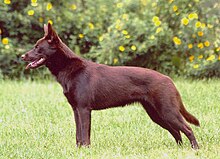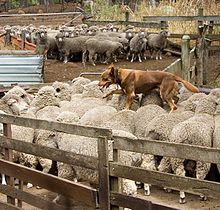Australian Kelpie
| Australian Kelpie | |||||||||||||||||||||||||
|---|---|---|---|---|---|---|---|---|---|---|---|---|---|---|---|---|---|---|---|---|---|---|---|---|---|
 A red Australian Kelpie | |||||||||||||||||||||||||
| Other names | Kelpie, Barb | ||||||||||||||||||||||||
| Common nicknames | Farmer Dog | ||||||||||||||||||||||||
| Origin | Australia | ||||||||||||||||||||||||
| |||||||||||||||||||||||||
| |||||||||||||||||||||||||
| Dog (domestic dog) | |||||||||||||||||||||||||
The Australian Kelpie, or simply Kelpie, is an Australian sheep dog successful at mustering and droving with little or no guidance. It is a medium-sized dog and comes in a variety of colours. The Kelpie has been exported throughout the world and is used to muster livestock, primarily sheep, cattle and goats.
The breed has been separated into two distinct varieties: the Show (or Bench) Kelpie and the Working Kelpie.[2] The Show Kelpie is seen at conformation dog shows in some countries and is selected for appearance rather than working instinct, while the Working Kelpie is bred for working ability rather than appearance.[2]
Appearance

The Kelpie is a soft-coated, medium-sized dog, generally with prick ears and an athletic appearance. Coat colours include black, black and tan, red, red and tan, blue, blue and tan, fawn, fawn and tan, cream, black and blue, and white and gold. The Kelpie generally weighs 14–20 kg (31–44 lb) and measures 41–51 cm (16–20 in) at the withers.[3]
Breed standards
Robert Kaleski published the first standard for the Kelpie in 1904. The standard was accepted by leading breeders of the time and adopted by the Kennel Club of New South Wales.[4] Contemporary breed standards vary depending on whether the registry is for working or show Kelpies. It is possible for a dog to both work and show, but options for competition in conformation shows might be limited depending on ancestry and the opinions of the kennel clubs or breed clubs involved.
In Australia, there are two separate registries for Kelpies.Working Kelpies are registered with the Working Kelpie Council (WKC)[5] and/or the Australian Sheepdog Workers Association.[6] The WKC encourages breeding for working ability, and allows a wide variety of coat colours. Show Kelpies are registered with the Australian National Kennel Council, which encourages breeding for a certain appearance and limits acceptable colours. The wide standards allowed by the WKC mean that Working Kelpies do not meet the standard for showing.
Outside Australia
In the US, the Kelpie is not recognised as a breed by the American Kennel Club (AKC).[7] However, the United Kennel Club and the Canadian Kennel Club recognise the Kelpie and allow them to compete in official events.[8][9] As of 2015, Australian Kelpies have been accepted by the AKC as Herding Dogs allowed to compete in AKC sanctioned Sheep Herding Trials. [10]
Working Kelpie



The Working Kelpie comes in three coat types: smooth, short, and rough. The coat can be almost every colour from black through light tan or cream. Some Kelpies have a white blaze on the chest, and a few have white points. Kelpies sometimes have a double coat, which sheds out in spring in temperate climates. Agouti is not unusual, and can look like a double coat.
Working Kelpies vary in size, ranging from about 19 inches (48cm) to as much as 25 inches (63.5cm) and from 28-60 lbs (12.7-27 kg). The dog's working ability is unrelated to appearance, so stockmen looking for capable working dogs disregard the dog's appearance.
A Working Kelpie can be a cheap and efficient worker that can save farmers and graziers the cost of several hands when mustering livestock.[11] The good working Kelpies are herding dogs that will prevent stock from moving away from the stockman.[12] This natural instinct is crucial when mustering stock in isolated gorge country, where a good dog will silently move ahead of the stockman and block up the stock (usually cattle) until the rider appears. The preferred dogs for cattle work are Kelpies, often of a special line, or a Kelpie cross.[13] They will drive a mob of livestock long distances in extremes of climates and conditions. Kelpies have natural instincts for managing livestock. They will work sheep, cattle, goats, pigs, poultry, and other domestic livestock. The Kelpie's signature move is to jump on the backs of sheep and walk across the tops of the sheep to reach the other side and break up the jam. A good working Kelpie is a versatile dog—they can work all day on the farm, ranch, or station, and trial on the weekends. Kelpies compete and are exhibited in livestock working trials, ranging from yards or arenas to large open fields working sheep, goats, cattle, or ducks.[14]
Show Kelpies
Show Kelpies are restricted to solid colours (black, chocolate, red, smoky blue, fawn, black and tan, red and tan) in a short double coat with pricked ears. It was during the early 20th century that Kelpies were first exhibited, at the Sydney Royal Easter Show.[14] Different kennel clubs'[citation needed] breed standards have preferences for certain colours. Show Kelpies are generally heavier and shorter than working Kelpies.[citation needed]
Temperament

Show Kelpies generally excel in agility trials and may be shown in conformation in Australia.
Health
Kelpies are a hardy breed with few health problems, but they are susceptible to disorders common to all breeds, like cryptorchidism, hip dysplasia, cerebellar abiotrophy and luxating patella. Current research is underway to find the genetic marker for cerebellar abiotrophy in the breed.[citation needed]
History

The ancestors of the Kelpie were simply (black) dogs, called Colleys or Collies. The word "collie" has the same root as "coal" and "collier (ship)".[15][16] Some of these collies were imported to Australia for stock work in the early 19th century, and were bred to other types of dogs (possibly including the occasional Dingo), but always with an eye to working sheep without direct supervision. Today's Collie breeds were not formed until about ten or 15 years after the Kelpie was established as a breed,[17] with the first official Border Collie not brought to Australia until after Federation in 1901.[18]
Kelpies have been claimed to have some Dingo blood; as it was illegal to keep dingoes as pets, some dingo owners registered their animals as Kelpies or Kelpie crosses. Kelpies and dingoes are similar in conformation and colouring. There is no doubt that some people have deliberately mated dingoes to their Kelpies, and some opinion holds that the best dilution is 1/16–1/32, but that 1/2 and 1/4 will work.[19] As the Dingo has been regarded as a savage sheep-killer since the first European settlement of Australia, few will admit to the practice.[19]
The first "Kelpie" was a black and tan female pup with floppy ears bought by Jack Gleeson about 1872[20] from a litter born on Warrock Station near Casterton, owned by George Robertson, a Scot. This dog was named after the mythological kelpie from Celtic folklore.[21] Legend has it that "Kelpie" was sired by a dingo, but there is little evidence for or against this. In later years she was referred to as "(Gleeson's) Kelpie", to differentiate her from "(King's) Kelpie", her daughter. The second "Kelpie" was "(King's) Kelpie", another black and tan bitch out of "Kelpie" by "Caesar", a pup from two sheep-dogs imported from Scotland. Again, there are legends that these two sheep-dogs may never have seen Scotland, and may have had dingo blood. "(King's) Kelpie" tied the prestigious Forbes Trial in 1879,[22] and the strain was soon popularly referred to as "Kelpie's pups", or just Kelpies. The King brothers joined another breeder, McLeod, to form a dog breeding partnership whose dogs dominated trials during 1900 to 1920.[20]
An early Kelpie, Sally was mated to Moss a smooth haired Collie and she produced a black pup that was named Barb after the black horse, The Barb who won the Melbourne Cup in 1866. This then was how black Kelpies became known as Barb Kelpies.[14]
There were a number of Kelpies called 'Red Cloud'. The first and most famous was John Quinn's Red Cloud in the early 20th century, and then in the 1960s another "Red Cloud" that became very well known in Western Australia. This started the tradition in Western Australia of calling all red or red and tan Kelpies, especially those with white chests, Red Cloud Kelpies.[23]
Kelpies have now been exported to many countries including Argentina, Canada, Italy, Korea, New Caledonia, New Zealand, Sweden, the United Kingdom and the United States for various pursuits.[14]

Recently Kelpies have been trained as scent dogs with good success rates. In Sweden they are widely used for tracking and rescue work.[14]
The Australian legend Red Dog died November 21, 1979. A movie based on this story was made in 2011.
Show coat colours
-
Black Kelpie
-
Chocolate Kelpie
-
Red Kelpie
-
Black and tan Kelpie
-
Red and tan Kelpie
-
Smokeblue Kelpie
-
Fawn Kelpie
Notable specimens
See also
References
- ^ New Zealand Kennel Club. "Australian Kelpie". Breed Standard. Retrieved 2014-12-03.
- ^ a b c "Australian Working Kelpie". Burke's Backyard. Retrieved 2011-11-01.
- ^ "Kelpie". Funk & Wagnalls New World Encyclopedia. World Almanac Education Group. 2002.
- ^ Walsh, G. P. "Kaleski, Robert Lucian Stanislaus (1877–1961)". Australian Dictionary of Biography. National Centre of Biography, Australian National University. Retrieved 16 September 2011.
- ^ The Working Kelpie Council of Australia
- ^ The Australian Sheepdog Workers' Association
- ^ Complete Breed List
- ^ United Kennel Club. "Australian Kelpie".
- ^ "CKC Breed Standards". Archived from the original on 2013-10-05.
- ^ http://www.akc.org/dog-breeds/working-kelpie/
- ^ Farming Ahead, Learning to train your four-legged workers, February 1997
- ^ Parsons, A.D.Tony, The Working Kelpie, Thomas Nelson, Melbourne, 1986
- ^ Messner, Andrew, Green Gully Historical Report, New South Wales Department of Environment and Conservation, 2006
- ^ a b c d e Sloane, Steve, Australian Kelpie, T.F.H. Publications, Inc., USA
- ^ "COAL etymology"
- ^ "COLLIE etymology"
- ^ THE KELPIE STORY
- ^ Early Australian Working Kelpie History
- ^ a b CROSSBREEDING DINGOES WITH SHEEPDOGS - PAGE 2
- ^ a b Parsons, AD, The Working Kelpie, Nelson, Melbourne, 1986
- ^ The Kelpie Foundation & John D Jack Gleeson
- ^ Historical Sheepdog Trials
- ^ Hey dogs Retrieved 2009-11-6
Further reading
- Hartnagle-Taylor, Jeanne Joy; Taylor, Ty (2010). Stockdog Savvy. Alpine Publications. ISBN 978-1-57779-106-5.
External links
- Working Kelpie Council
- North American Australian Kelpie Registry
- Kelpie coat colour genetics
- Kelpiegallery - online photogallery of Australian Kelpie registered in FCI/ANKC
- Australian Kelpie - photo gallery of Australian Kelpie







